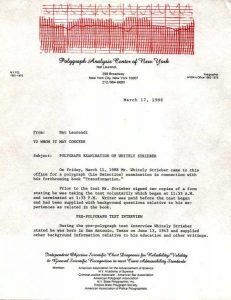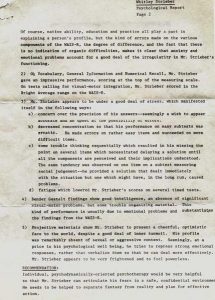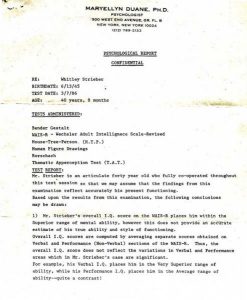From the first few months after his startling recollection of the ordeal related in his book Communion, to the beginning of 1999, Whitley Strieber has been subjected to a battery of psychological and polygraphic tests. The result: he’s telling the truth. Whereas the body of professional documentation presented here represents only a portion of the tests Strieber underwent, they support his continuing assertion that he was not suffering from either a physical or mental disorder at the time of the experiences, nor was he merely lying about them.
The test results include an EEG and MRI done in 1986 and 1987, polygraph (“lie detector”) tests performed in New York and London, and two psychological analyses from different doctors. The most recent of these was done in January of 1999. These original documents are published here for the first time
(click on each image to view an enlargement).
The EEG: Testing for Temporal Lobe Epilepsy
 This is a report on the test that Whitley took for Temporal Lobe Epilepsy (TLE) in December of 1986. This disease causes vivid hallucinations, and could conceivably have been an explanation for his experiences. However, the test showed no evidence of the disease. An aggressive methodology was used that included inserting leads into Whitley’s sinuses.
This is a report on the test that Whitley took for Temporal Lobe Epilepsy (TLE) in December of 1986. This disease causes vivid hallucinations, and could conceivably have been an explanation for his experiences. However, the test showed no evidence of the disease. An aggressive methodology was used that included inserting leads into Whitley’s sinuses.
An important symptom of TLE is revealed in an EEG as “spike discharges” at the location of the brain’s temporal lobe, particularly during sleep. The test states that “no… abnormalities or epileptiform discharges” were found, and that the EEG result is “normal”, including during sleep.
The veracity or even the existance of this test has come under question, particularly from very vocal debunkers like Phillip Klass. Klass could not conceive of this test having been done in early December, while still being mentioned in Communion, published the following January1.
The MRI: Other brain abnormalities ruled out
 Whitley’s MRI scan of March 1988 showed unknown bright objects in his brain. Such objects appear in a small percentage of MRI scans of the brain, and in large numbers can be associated with diseases like muscular dystrophy. However, Whitley’s were believed to be medically insignificant, and he has never suffered any symptoms of neuromuscular disorder.
Whitley’s MRI scan of March 1988 showed unknown bright objects in his brain. Such objects appear in a small percentage of MRI scans of the brain, and in large numbers can be associated with diseases like muscular dystrophy. However, Whitley’s were believed to be medically insignificant, and he has never suffered any symptoms of neuromuscular disorder.
Both the EEG and the MRI were suggested by Dr. Donald Klein, the psychiatrist with whom Strieber first began therapy for the symptoms arising as a result of his experiences. The tests were carried out by neurologists. It was Dr. Klein who had raised the issue of TLE, and who has affirmed that all neurological tests came back negative, indicating no abnormalities. Indeed, Dr. Klein has asserted that it would be “foolish” to ascribe the reported experiences to TLE, or any other abnormality, including psychosis2.
Nat Laurendi’s Polygraph Tests
Whitley’s first polygraph was administered by New York polygraphist Nat Laurendi. Mr. Laurendi was extensively experienced, having worked for many years with the New York City Police Department. The test indicated that Whitley was being truthful in describing his 1985 close encounter. The first polygraph was administered on October 31, 1986, and Mr. Laurendi was interviewed about it on-air a number of times. However, he did not provide Whitley a formal report. Whitley took a second polygraph from Mr. Laurendi in March of 1988 prior to the publication of Transformation, and the formal report, reproduced here, was provided.
Apparently Mr. Laurendi projected an irrascible persona, even reading Strieber his Miranda rights as a control, and there was some disagreement about a question regarding cults in the first test. Laurendi unequivocally concludes, however, that Strieber is sincere: “Does he believe what he is saying? As a polygraphist, I have to say yes.”3
The BBC polygraphs
 Before the British Broadcasting Corporation in London would allow Whitley to appear on any of its programs, it insisted that he pass a polygraph arranged by them. Again, he was found to be telling the truth about his encounter.
Before the British Broadcasting Corporation in London would allow Whitley to appear on any of its programs, it insisted that he pass a polygraph arranged by them. Again, he was found to be telling the truth about his encounter.
This test was performed during the promotional tour for Communion in May 1987.
It will be noticed that this test, and Nat Laurendi’s test of 1988, contain only a few questions. Laurendi has stated that the optimal number of relevant questions for a polygraph test is four to six. The eighteen questions asked in the polygraph test appearing in Appendix II of Communion include control questions, as well as the core set of relevant questions.
The first psychological assessments
Whitley took a complete battery of psychological tests a few months after his encounter. The test presented here revealed that “Mr. Strieber appears to be very frightened and to feel powerless.” This is a powerful indication that the encounter experience was devastating to him emotionally, just as he reports in his books.
This test, administered by psychologist Maryellyn Duane in New York, is significant because it was performed only two and a half months following Strieber’s first recollected encounter in December 1985. While acknowledging his feeling of powerlessness, Dr. Duane also reaffirms that there are no indications of any physical abnormalities, presumably with his brain, that would account for the stress that led him to seek professional help.
The latest psychological tests
In January 1999, Whitley once again had a psychological evaluation. It continues to indicate that he is simply a normal adult under stress, stating his “adequate reality orientation with no indications of severe emotionality.” The report further states that “this individual appears to be experiencing tension at the present time”.
Even fifteen years after his first encounter, he remains stressed.
Notes:
1. Ed Conroy, Report On Communion, (New York: Avon Books, 1989), pp. 206-207.
2. Ibid., pp. 23-24.
3. Ibid., p. 39.
Subscribers, to watch the subscriber version of the video, first log in then click on Dreamland Subscriber-Only Video Podcast link.







Have you ever had a functional MRI of your Pineal Gland to see the size and blood flow through it? I suspect this may be a key to expanded perceptions which may be similar to T.L.E. or even mistaken for such. I have seen evidence that those with extra ordinarily high I.Q.’s also have very large Pineal Glands, or very high blood flow through it. They may suffer from Higher than normal blood pressure without the ill effects, but do have head aches.